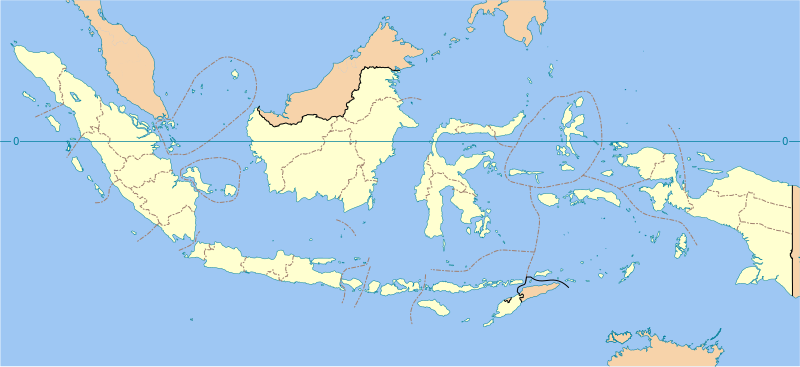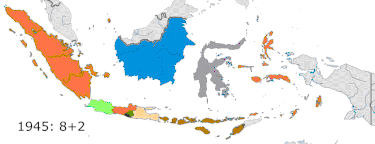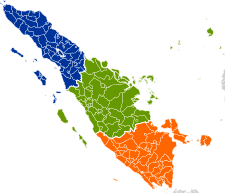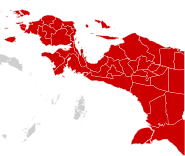Provinces of Indonesia
| Provinces of Indonesia Provinsi di Indonesia | |
|---|---|
 | |
| Category | First-level administrative division of a decentralized unitary state |
| Location | Republic of Indonesia |
| Created |
|
| Number | 38 |
| Populations | South Papua (534,400) – West Java (49,860,300) |
| Areas | Jakarta 661 km2 (255 sq mi) – Central Kalimantan 153,444 km2 (59,245 sq mi) |
| Government | |
| Subdivisions | |
| This article is part of a series on |
| Subdivisions of Indonesia |
|---|
| Level 1 |
|
| Level 2 |
|
| Level 3 |
| (kecamatan, distrik, kapanewon, or kemantren) |
| Level 4 |
| (desa or kelurahan) |
| Others |
Provinces are the first-level administrative divisions of Indonesia. It is formerly called the first-level provincial region (provinsi daerah tingkat I) before the Reform era. Provinces have a local government, consisting of a governor (Gubernur) and a regional legislative body (Dewan Perwakilan Rakyat Provinsi). The governor and members of local representative bodies are elected by popular vote for five-year terms, but governors can only serve for two terms. Provincial governments have the authority to regulate and manage their own government affairs, subject to the limits of the central government. The average land area of all 38 provinces in Indonesia is about 49,800 km2 (19,200 sq mi), and they had an average population in mid 2023 of 7,334,111 people.
Currently, Indonesia is divided into 38 provinces, nine of which have special autonomous status. The terminology for special status are "Istimewa" and "Khusus", which translates to 'special' or 'designated' in English. Provinces are further divided into regencies and cities (formerly called second-level region regencies/cities or kabupaten/kotamadya daerah tingkat II), which are in turn subdivided into districts (kecamatan). Proposals for the creation of additional provinces (by the splitting of existing provinces) have been considered by the Indonesian government, but further action has been suspended since 2013 under a moratorium declared on any creations of further provinces, regencies or cities. However, in 2022, 9 years later, Central Papua, Highland Papua, South Papua, and Southwest Papua became the youngest provinces in the country.
Background
[edit]Article 18 paragraph 1 of the 1945 Constitution states that "the Unitary State of the Republic of Indonesia is divided into provincial regions and those provincial regions are divided into regencies and city, whereby every one of those provinces, regencies, and municipalities has its regional government, which shall be regulated by laws."
According to the Law on Regional Government (UU 23/2014) the authority of the Provincial Government includes:
- Development planning and control;
- Planning, utilization, and community peace;
- Implementation of public order and public peace;
- Provision of public facilities and infrastructure;
- Handling the health sector;
- Education and allocation of potential human resources;
- Handling social problems across regencies/cities;
- Services in the field of manpower across regencies/cities;
- Facilitating the development of cooperatives, small and medium enterprises, including across districts/cities;
- Environmental control;
- Defense services, including across regencies/cities;
- Population and civil registration services;
- Government general administration services;
- Investment administration services, including across regencies/cities;
- The implementation of other basic services that cannot be carried out by regencies/cities; and
- Other mandatory affairs mandated by laws and regulations.
The authority of the provincial government are government affairs which are located across regencies/municipalities, government affairs whose users are across regencies/municipalities, government affairs whose benefits or negative impacts lie across regencies/municipalities, government affairs which use more resources. efficient if carried out by the province.
Each province has a local government, headed by a governor and a legislative body (DPRD). The governor and members of local representative bodies are elected by popular vote for five-year terms, but governors can only serve for two terms. The general election to elect members of the DPRDs is conducted simultaneously with the national general election. Previously, the general elections for Governor and Vice Governor were not held simultaneously. However, since 2015 regional head elections have been held simultaneously. Under the plan, simultaneous partial local elections were held in February 2017, June 2018 and December 2020, culminating in simultaneous elections for all local executive posts in November 2024 and then every five years.
Current provinces
[edit]
| Coat of arms | Name[1][2] | Reg. code |
ISO[3] | Capital | Largest city | Population (mid 2023) [4] |
Area (km2) |
Density per km2 (mid 2023)[5] |
Geographical unit |
No. of Cities |
No. of Reg. |
|---|---|---|---|---|---|---|---|---|---|---|---|
 |
Aceh | 11 | ID-AC | 5,482,500 | 56,835 | 96 | Sumatra | 5 | 18 | ||
 |
North Sumatra Sumatera Utara |
12 | ID-SU | 15,386,600 | 72,461 | 212 | Sumatra | 8 | 25 | ||
 |
West Sumatra Sumatera Barat |
13 | ID-SB | 5,757,200 | 42,120 | 137 | Sumatra | 7 | 12 | ||
| Riau | 14 | ID-RI | 6,642,900 | 89,936 | 74 | Sumatra | 2 | 10 | |||
 |
Jambi | 15 | ID-JA | 3,679,200 | 49,027 | 75 | Sumatra | 2 | 9 | ||
 |
South Sumatra Sumatera Selatan |
16 | ID-SS | 8,743,500 | 91,592 | 101 | Sumatra | 4 | 13 | ||
 |
Bengkulu | 17 | ID-BE | 2,086,000 | 20,128 | 104 | Sumatra | 1 | 9 | ||
| Lampung | 18 | ID-LA | 9,314,000 | 33,570 | 277 | Sumatra | 2 | 13 | |||
 |
Bangka Belitung Islands Kepulauan Bangka Belitung |
19 | ID-BB | 1,511,900 | 16,690 | 91 | Sumatra | 1 | 6 | ||
| Riau Islands Kepulauan Riau |
21 | ID-KR | 2,152,600 | 8,270 | 260 | Sumatra | 2 | 5 | |||
 |
Special Capital Region of Jakarta Daerah Khusus Ibukota Jakarta |
31 | ID-JK | 10,672,100 | 661 | 16,146 | Java | 5 | 1 | ||
 |
West Java Jawa Barat |
32 | ID-JB | 49,860,300 | 37,045 | 1,346 | Java | 9 | 18 | ||
 |
Central Java Jawa Tengah |
33 | ID-JT | 37,541,000 | 34,337 | 1,093 | Java | 6 | 29 | ||
 |
Special Region of Yogyakarta Daerah Istimewa Yogyakarta |
34 | ID-YO | 3,736,500 | 3,171 | 1,178 | Java | 1 | 4 | ||
| East Java Jawa Timur |
35 | ID-JI | 41,527,900 | 48,037 | 865 | Java | 9 | 29 | |||
 |
Banten | 36 | ID-BT | 12,307,700 | 9,353 | 1,316 | Java | 4 | 4 | ||
 |
Bali | 51 | ID-BA | 4,404,300 | 5,590 | 788 | Lesser Sunda Islands | 1 | 8 | ||
| West Nusa Tenggara Nusa Tenggara Barat |
52 | ID-NB | 5,560,300 | 19,676 | 283 | Lesser Sunda Islands | 2 | 8 | |||
 |
East Nusa Tenggara Nusa Tenggara Timur |
53 | ID-NT | 5,569,100 | 46,447 | 120 | Lesser Sunda Islands | 1 | 21 | ||
| West Kalimantan Kalimantan Barat |
61 | ID-KB | 5,623,300 | 147,037 | 38 | Kalimantan | 2 | 12 | |||
| Central Kalimantan Kalimantan Tengah |
62 | ID-KT | 2,773,700 | 153,444 | 18 | Kalimantan | 1 | 13 | |||
| South Kalimantan Kalimantan Selatan |
63 | ID-KS | 4,222,300 | 37,135 | 114 | Kalimantan | 2 | 11 | |||
 |
East Kalimantan[6] Kalimantan Timur |
64 | ID-KI | 3,909,700 | 126,981 | 31 | Kalimantan | 3 | 7 | ||
| North Kalimantan Kalimantan Utara |
65 | ID-KU | 730,000 | 70,101 | 10 | Kalimantan | 1 | 4 | |||
 |
North Sulawesi Sulawesi Utara |
71 | ID-SA | 2,681,500 | 14,500 | 185 | Sulawesi | 4 | 11 | ||
| Central Sulawesi Sulawesi Tengah |
72 | ID-ST | 3,086,800 | 61,606 | 50 | Sulawesi | 1 | 12 | |||
 |
South Sulawesi Sulawesi Selatan |
73 | ID-SN | 9,362,300 | 45,331 | 207 | Sulawesi | 3 | 21 | ||
 |
Southeast Sulawesi Sulawesi Tenggara |
74 | ID-SG | 2,749,000 | 36,160 | 76 | Sulawesi | 2 | 15 | ||
 |
Gorontalo | 75 | ID-GO | 1,213,200 | 12,025 | 101 | Sulawesi | 1 | 5 | ||
 |
West Sulawesi Sulawesi Barat |
76 | ID-SR | 1,481,100 | 16,595 | 89 | Sulawesi | 0 | 6 | ||
 |
Maluku | 81 | ID-MA | 1,920,500 | 46,158 | 42 | Maluku Islands | 2 | 9 | ||
 |
North Maluku Maluku Utara |
82 | ID-MU | 1,337,100 | 32,999 | 41 | Maluku Islands | 2 | 8 | ||
| West Papua Papua Barat |
92 | ID-PB[7] | 569,600 | 60,275 | 9 | Western New Guinea | 0 | 7 | |||
 |
Southwest Papua Papua Barat Daya |
96 | ID-PD | 617,700 | 39,123 | 16 | Western New Guinea | 1 | 5 | ||
 |
Papua | 91 | ID-PA | 1,047,100 | 82,681 | 13 | Western New Guinea | 1 | 8 | ||
| South Papua Papua Selatan |
93 | ID-PS | 534,400 | 117,849 | 5 | Western New Guinea | 0 | 4 | |||
| Central Papua Papua Tengah |
94 | ID-PT | 1,452,800 | 61,073 | 24 | Western New Guinea | 0 | 8 | |||
 |
Highland Papua Papua Pegunungan |
95 | ID-PE | 1,448,400 | 51,213 | 28 | Western New Guinea | 0 | 8 | ||
Special autonomy
[edit]The decentralization of some power and autonomy to provinces is called for by Article 18 of the Constitution of Indonesia, and this article was expanded through amendments in October 1999 in the period following the fall of Suharto.[8]: 35–37 Some provinces have been granted additional autonomy beyond this. The form this special autonomy takes is not standardized, with provinces gaining different formulations of specific autonomy based on particular political imperatives.[8]: 38–39
- The Special Region of Yogyakarta, which was autonomous under Dutch rule, was (along with Surakarta) given consideration for autonomy as part of Law no. 1 of 1945. Autonomy for Yogyakarta was confirmed directly through Law no. 3 of 1950, the first granting of special autonomy to a province. This status has been maintained until the present, with some tweaks from additional laws.[8]: 39–40 Sultan Hamengkubuwono serves as a hereditary governor and Adipati Paku Alam as a hereditary vice-governor.
- Rebellion in Aceh due to demands for a stricter implementation of Islamic law has led to several shifts in political status. Specific autonomy was initially granted to the province through Law no. 24 of 1956. Further autonomy was given through the declaration that Aceh was a "special region" on 23 May 1959, later formalized through Law no. 18 of 1965. Following the fall of Suharto, Law no. 44 of 1999 and Law no. 18 of 2001 created a new framework that was adopted by both parties through Law no. 11 of 2006. This law provides privileged status regarding implementation of Islamic law in religious life, customary life, and education. Aceh also received its own development fund for a period of 20 years.[8]: 44–46
- The province of Papua was granted special autonomy through Law no. 21 of 2001. This was a response to independence movements that had been present in the province since it became part of Indonesia, and occurred alongside the renaming of the province from Irian Jaya to Papua.[8]: 42–43 [9] This gave Papua a greater portion of revenue, autonomy outside reserved areas maintained by the central government, and 20 years of a special development fund. Before special autonomy was implemented, West Papua was split from Papua in 2003, although both kept special autonomy.[10] The special autonomy for both provinces was renewed in 2021, including a renewal and increase of the special autonomy fund.[11] Included in this new legislation was the provision to create new provinces, and in July 2022 new national legislation split South Papua, Central Papua, Highland Papua from Papua[12] through Law Number 14 of 2022, Law Number 15 of 2022, and Law Number 16 of 2022 respectively.[9] Law No. 29 of 2022 was enacted in December 2022 splitting Southwest Papua from West Papua.[13] All the split provinces retained their autonomous status.
- The Special Region of Jakarta has its own status, due to it being the country's economic capital and largest city.[14]
Geographical units
[edit]The provinces are officially grouped into seven geographical units for statistical and national planning purposes, but without administrative function.[15]
Former provinces
[edit]
Upon the independence of Indonesia, eight provinces were established. West Java, Central Java, East Java, and Maluku still exist as of today despite later divisions, while Sumatra, Kalimantan, Sulawesi, and Nusa Tenggara, formerly Lesser Sunda (Sunda Kecil) were fully liquidated by dividing them into new provinces. The province of Central Sumatra existed from 1948 to 1957, while East Timor was annexed as a province from 1976 until its power transfer to UNTAET in 1999 prior to its independence as a country in 2002.
| Province | Capital | Period | Successor(s) |
|---|---|---|---|
| Special Region of Surakarta (Daerah Istimewa Surakarta)[17] |
Surakarta | 1945–1946 | Central Java |
| Sumatra[18] | Bukittinggi / Medan | 1945–1948 | Central Sumatra North Sumatra South Sumatra |
| Kalimantan[19] | Banjarmasin | 1945–1956 | East Kalimantan South Kalimantan West Kalimantan |
| Nusa Tenggara[20] | Singaraja | 1945–1958 | Bali East Nusa Tenggara West Nusa Tenggara |
| Sulawesi[21] | Makassar / Manado | 1945–1960 | North-Central Sulawesi South-Southeast Sulawesi |
| Central Sumatra (Sumatera Tengah)[18][22] |
Bukittinggi | 1948–1957 | Jambi Riau West Sumatra |
| North-Central Sulawesi (Sulawesi Utara-Tengah)[23] |
Manado | 1960–1964 | North Sulawesi Central Sulawesi |
| South-Southeast Sulawesi (Sulawesi Selatan-Tenggara)[23] |
Makassar | 1960–1964 | South Sulawesi Southeast Sulawesi |
| East Timor (Timor Timur)[24] |
Dili | 1976–1999 | Democratic Republic of Timor-Leste |
New provinces made from currently-existing provinces
[edit]
| New province (current name) |
Year | New province (then name) |
Province of origin |
|---|---|---|---|
| Special Region of Yogyakarta | 1950 | Yogyakarta | Central Java |
| Aceh | 1956 | Aceh | North Sumatra |
| Central Kalimantan | 1958 | Central Kalimantan | South Kalimantan |
| Jakarta Special Capital Region | 1959 | Greater Jakarta | West Java |
| Lampung | 1964 | Lampung | South Sumatra |
| Bengkulu | 1967 | Bengkulu | South Sumatra |
| North Maluku | 1999 | North Maluku | Maluku |
| Banten | 2000 | Banten | West Java |
| Bangka Belitung Islands | 2000 | Bangka Belitung Islands | South Sumatra |
| Gorontalo | 2000 | Gorontalo | North Sulawesi |
| Riau Islands | 2002 | Riau Islands | Riau |
| West Papua | 2003 | West Irian Jaya | Irian Jaya |
| West Sulawesi | 2004 | West Sulawesi | South Sulawesi |
| North Kalimantan | 2012 | North Kalimantan | East Kalimantan |
| Central Papua | 2022 | Central Papua | Papua |
| Highland Papua | 2022 | Highland Papua | Papua |
| South Papua | 2022 | South Papua | Papua |
| Southwest Papua | 2022 | Southwest Papua | West Papua |
Renamed provinces
[edit]| Year | Old name (Indonesian) |
Old name (English) |
New name (Indonesian) |
New name (English) |
Current name |
|---|---|---|---|---|---|
| 1954 | Sunda Kecil | Lesser Sunda | Nusa Tenggara | Nusa Tenggara | non-existent |
| 1959 | Aceh | Aceh | Daerah Istimewa Aceh | Aceh Special Region | Aceh |
| 1961 | Jakarta Raya | Greater Jakarta | Daerah Khusus Ibukota Jakarta Raya | Greater Jakarta Special Capital Region | Jakarta Special Capital Region |
| 1973 | Irian Barat | West Irian | Irian Jaya | Irian Jaya | Papua |
| 1990 | Daerah Khusus Ibukota Jakarta Raya | Greater Jakarta Special Capital Region | Daerah Khusus Ibukota Jakarta | Jakarta Special Capital Region | Special Region of Jakarta |
| 2001 | Daerah Istimewa Aceh | Aceh Special Region | Nanggroë Aceh Darussalam | State of Aceh, the Abode of Peace | Aceh |
| 2002 | Irian Jaya | Irian Jaya | Papua | Papua | Papua |
| 2007 | Irian Jaya Barat | West Irian Jaya | Papua Barat | West Papua | West Papua |
| 2009 | Nanggroë Aceh Darussalam | State of Aceh, the Abode of Peace | Aceh | Aceh | Aceh |
Former provincial capitals
[edit]- Tanjungpinang to Pekanbaru, Riau (until 1959)
- Jakarta to Bandung, West Java (until 1960)
- Singaraja to Denpasar, Bali (until 1960)
- Soasio to Sukarnapura, West Irian (1956–1963)
- Dili, East Timor (1975–1999), later became the capital of Democratic Republic of Timor-Leste
- Ternate to Sofifi, North Maluku (until 2010)
- Banjarmasin to Banjarbaru, South Kalimantan (until 2022)
See also
[edit]Notes
[edit]- ^ Jakarta is a city with province-level Capital Special Region comprising five Kota Administrasis (administrative cities/municipalities) and one Kabupaten Administrasi (administrative regency). It has no de jure capital, but many governmental buildings are located at Central Jakarta.
References
[edit]- ^ "Data Wilayah – Kementerian Dalam Negeri – Republik Indonesia". Archived from the original on 2012-02-22. Retrieved 2011-02-16.
- ^ Buku Induk—Kode dan Data Wilayah Administrasi Pemerintahan per Provinsi, Kabupaten/Kota dan Kecamatan Seluruh Indonesia (PDF) (in Indonesian), Kementerian Dalam Negeri [Ministry of Home Affairs], archived from the original (PDF) on 2016-11-19
- ^ ISO 3166-2:ID (ISO 3166-2 codes for the provinces of Indonesia)
- ^ Badan Pusat Statistik/Statistics Indonesia, Jakarta, 2024.
- ^ Badan Pusat Statistik/Statistics Indonesia, Jakarta, 2024.
- ^ Figures adjusted to take account of the separation of Tarakan city and four regencies, as confirmed by Badan Pusat Statistik, to form the new province of North Kalimantan, listed separately in this table.
- ^ West Papua was created from the western portion of Papua province in February 2003, initially under the name of Irian Jaya Barat, and was renamed Papua Barat (West Papua) on 7 February 2007. The split remains controversial. In November 2004, the Constitutional Court of Indonesia ruled that the split violated Papua's autonomy laws. However, since the western province had already been created, it should remain separate from Papua. The ruling also aborted the creation of another proposed province, Central Irian Jaya, because the proposed split had not yet been completed. ISO 3166-2 codes have subsequently been published for all of the newly-created provinces in Indonesian Papua.
- ^ a b c d e Ahmad Ainun Najib; Indarja (April 2023). "Special Autonomy Dilemma in the 1945 Constitution of the Republic of Indonesia". Syiah Kuala Law Journal. 7 (1): 32–49. doi:10.24815/sklj.v7i1.28611.
- ^ a b "Naming process of new provinces in Papua Region, Indonesia" (PDF). United Nations Group of Experts on Geographical Names. 3 May 2023. p. 2. Retrieved 19 May 2024.
- ^ Budy P. Resosudarmo; Julius A. Mollet; Umbu R. Raya; Hans Kaiwai (2014). "Development in Papua after special autonomy". Regional Dynamics in a Decentralized Indonesia. ISEAS Publishing. p. 434. doi:10.1355/9789814519175-025.
- ^ Ronna Nirmala (15 July 2021). "Indonesia Passes New Papuan Autonomy Law; Separatists Reject it as Unsatisfactory". Retrieved 20 May 2024.
- ^ "Indonesia passes contentious law to create more provinces in Papua". CNN. 1 July 2022. Retrieved 19 May 2024.
- ^ "Southwest Papua officially becomes Indonesia's 38th province". Antara. 9 December 2022. Retrieved 19 May 2024.
- ^ "Prabowo Cabut Status DKI dari Jakarta, Berlaku Mulai Ini Ditetapkan!", Emir Yanwardhana, CNBC Indonesia, retrieved 10 December 2024
- ^ ISO 3166-2:ID
- ^ Badan Pusat Statistik, Jakarta, 2024.
- ^ "Pangeran Surakarta Ajukan Piagam Soekarno Jadi Bukti Keistimewaan". Constitutional Court of Indonesia. Retrieved 2023-06-20.
- ^ a b Peraturan Pemerintah Nomor 21 Tahun 1950 [Government Regulation Number 21 of 1950] (PDF) (Government Regulation 21) (in Indonesian). 1950. Archived from the original (PDF) on 2011-12-11.
- ^ Undang-Undang Nomor 25 Tahun 1956 [Act Number 25 of 1956]. hukumonline.com (Act 25) (in Indonesian). 1956.
- ^ Undang-Undang Nomor 64 Tahun 1958 [Act Number 64 of 1958]. hukumonline.com (Act 64) (in Indonesian). 1958.
- ^ Peraturan Pemerintah Pengganti Undang-Undang Nomor 47 Tahun 1960 [Government Regulation in Lieu of Law Number 47 of 1960] (Government Regulation in Lieu of Law 47) (in Indonesian). 1970.
- ^ Undang-Undang Darurat Nomor 19 Tahun 1957 [Ordinance-as-Act Number 19 Year 1957] (Ordinance-as-Act 19) (in Indonesian). 1957.
- ^ a b Undang-Undang Nomor 13 Tahun 1964 [Act Number 13 of 1964]. hukumonline.com (Act 13) (in Indonesian). 1964.
- ^ Undang-Undang Republik Indonesia Nomor 7 Tahun 1976 [Act of the Republic of Indonesia Number 7 of 1976] (PDF) (Act 7) (in Indonesian). 1976. Archived from the original (PDF) on 2018-11-14.
- ^ Meilani, Tri; Adji, Raka (13 July 2022). "The long-awaited birth of South Papua province". antaranews.com. Retrieved 22 February 2023.
- ^ "Southwest Papua Province inaugurated, Indonesia now has 38 provinces". Indonesiawindow.com. 10 December 2022. Retrieved 22 February 2023.


















